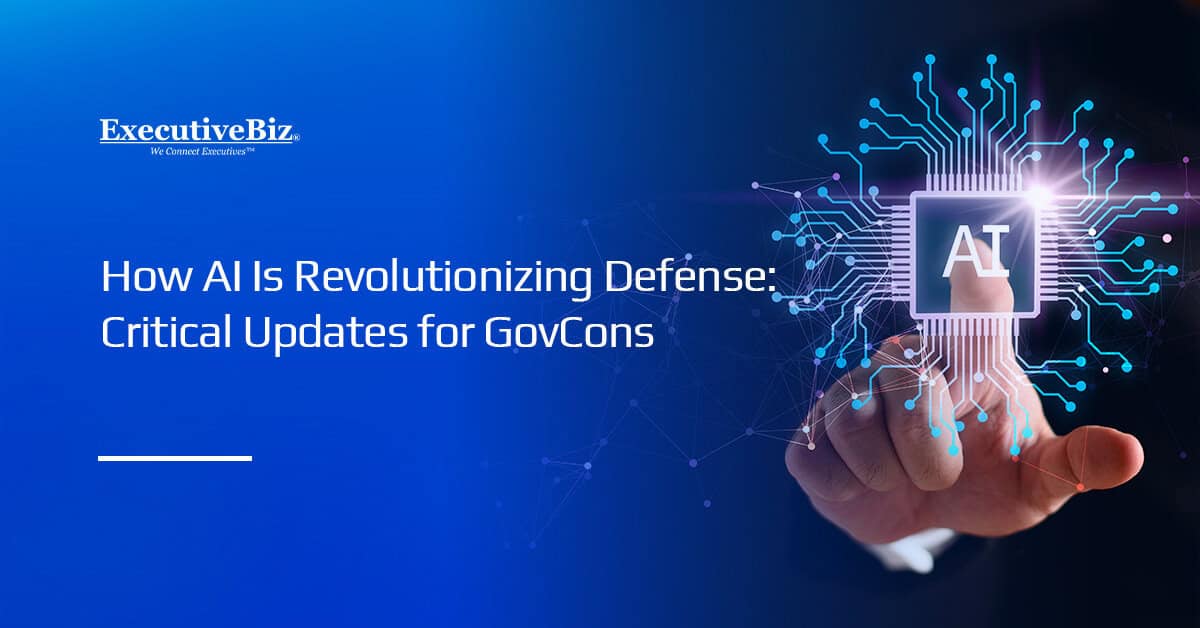Artificial intelligence is reshaping U.S. military technology. It’s driving how it builds ships, defends against missiles, flies fighter jets and even trains its forces. From a contractor partnership to boost shipyard productivity, to the Army’s vision of AI-driven missile defense and the Air Force’s AI-powered F-16 flights, the Pentagon is betting big on algorithms to enhance speed, efficiency and security.
Digital twin simulations fueled by satellite data are giving the military new ways to prepare for tomorrow’s battles. For GovCons, staying ahead in AI isn’t optional—it’s mission-critical.
These AI advancements are practical solutions already reshaping workflows, reducing manpower demands and enhancing warfighting capabilities. For defense contractors, AI is a competitive edge that will directly impact contracts, workflows and production efficiencies.
Dive into the most impactful ways AI is revolutionizing defense below.
Discover the latest military AI requirements at the Potomac Officers Club’s 2026 Defense R&D Summit on Jan. 29! Gain actionable intelligence at the “Powering AI at Mission Scale: Energy, Compute and Infrastructure for Defense Innovation” panel discussion. Have the meaningful face-to-face conversations with other GovCon titans that only take place at live events. Sign up today for this elite GovCon event and snag that big contract!
How Is AI Impacting Shipbuilding?
A Navy shipbuilder and an AI firm have teamed up to boost productivity through better employee scheduling. HII and C3 AI are working together to leverage intricate algorithms to reconfigure work schedules and make them more efficient.
HII has two major shipyards in Newport News, Va., and Pascagoula, Miss., that serve on a variety of the Navy’s key shipbuilding efforts. These include Ford-class carriers and San Antonio-class amphibious craft. C3 AI creates AI software on an enterprise scale for military and commercial use. The company has contracts with the Air Force.
Eric Chewning, HII executive vice president of maritime systems and corporate strategy, was quoted by Breaking Defense as saying AI could help the individual machining locations within each shipyard prioritize their work to meet the requirements of a variety of shipbuilding program schedules. These actions, he said, take place today via computer spreadsheets and conversations between people.
HII has a goal of increasing shipbuilding output by 20 percent in 2025.
Is AI Changing Missile Defense?
Probably the most well known example in defense is the Trump administration’s desire to use AI in the proposed Golden Dome homeland missile defense system. The Army seeks to use the technology to boost autonomy and slash manpower required to manage the multi-billion dollar system, Defense News has reported.
Maj. Gen. Frank Lozano, Army program executive officer for missiles and space, was quoted as saying that Golden Dome would probably have missiles and rockets installed in the ground or have containerized fires. These applications would have reduced maintenance as a smaller manpower footprint would reduce status checks to a couple times per month. Test checks, he said, could be performed from a distance.
The Army wants to leverage AI to develop a decision formula that would analyze data that becomes a human decision. Lozano said the service would need to code AI algorithms to compute that information and make a proper choice. He expects to have certain trigger points where the AI software says it is not allowed to make a certain decision before pushing it back to a human to decide.
An AI-powered fire control concept is considered fundamental to Golden Dome, according to a Defense One article. The technology is anticipated to support networking a variety of missile batteries and radar systems, possibly allowing many more missiles to be tracked than possible today. Some parts of modern missile defense systems, including target warning, already leverage AI elements.
Dive into the intersection of AI and 5G at the Potomac Officers Club’s 2026 Defense R&D Summit on Jan. 29! Hear directly from Thomas Rondeau, the Pentagon’s principal director for 5G and FutureG, during his keynote address about how AI is impacting his research. Check out the latest offerings from leading sponsors including Exiger, Nokia Federal Solutions and Vantor. Secure your seat today!
Can AI Fly Aircraft?
The Air Force has been experimenting for years with using AI to fly its jets. A major advancement came in May 2024 when former service secretary Frank Kendall flew in a F-16 fighter controlled not by human pilot, but by AI, the Associated Press reported.
The AI-powered F-16’s software first brushes up on millions of data points in a simulator. Then it tests its ideas in actual flight. That data tested in reality is reinserted back into the simulator to be re-processed by the AI to learn more.
The Air Force has human test pilots using classified simulators to train AI software to fly in combat.
The AI-controlled F-16, nicknamed Vista, performed maneuvers at speeds faster than 550 mph that pressures the human body at five times the force of gravity. Vista raced with another human-powered F-16 as both platforms came within 1,000 feet of each other while trying to force the other aircraft into compromising positions.
DOD’s pursuit of AI-powered aircraft is guided by cost, strategic capability and security. The Air Force believes its inventory of pricey, manned fighters would be vulnerable in combat against China because of China’s gains in space, air defense and electronic warfare technologies.
How to Create a Digital Twin Using AI?
Innovative companies are using AI-powered updates from information gathered from radars and satellites to produce digital twins of earth, according to National Defense Magazine.
The goal is to develop computerized environments that can be revisited and updated throughout the day, Aechelon Technology CEO and Co-Founder Nacho Sanz-Pastor said. The company provides the only sensor and visual systems used by the Coast Guard for pilot training. But a recurring challenge with simulation systems is that they are challenging to revise, requiring lots of manpower.
Since the USCG utilizes Aechelon’s sensor and visual system for pilot training, it can take software updates as required and available to leverage the real-time 3D visualizations. Other clients that have already worked with the company’s synthetic environment platforms, including the Air Force, Marine Corps, Special Operations Command and the Navy, can already benefit from new data dates and fresh capabilities.
A variety of space capabilities, such as regular imagery updates and satellite radar, allow Aechelon to refresh its content in minutes after a satellite passes overhead. Sanz-Pastor said every location on earth can be imaged many times per day, making things possible that were once unfathomable.






